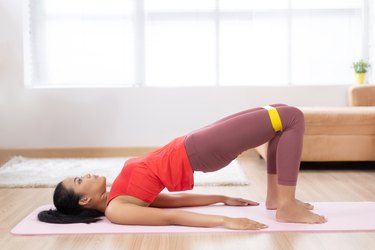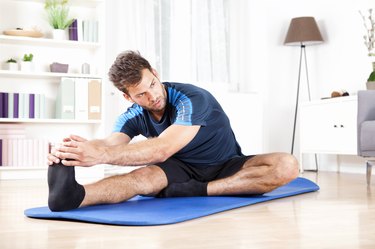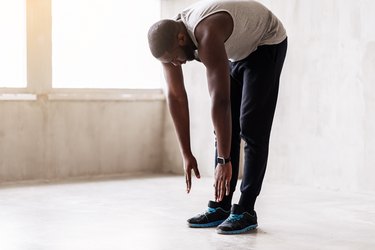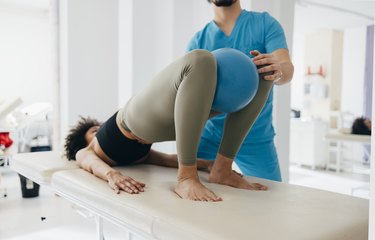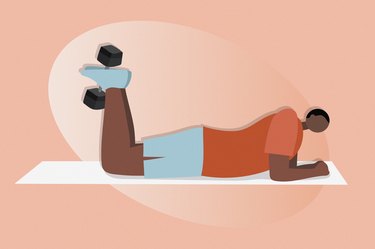

Deadlifts get a lot of praise for their hamstring-building ability. But if you really want to give your hamstrings a muscle-twitching challenge, the leg curl is a must-try exercise — just get ready for some post-workout soreness.
- What does the leg curl do? It's a hamstrings exercise that isolates and strengthens these muscles by bending your knees or "curling" your feet to your hips against resistance.
- What muscles does the exercise work? This exercise focuses on your hamstrings, the three long muscles across the back of your legs that connect your hips and knees, says California-based physical therapist and personal trainer Jereme Schumacher, PT, DPT.
- Are leg curls bad for your knees? Generally, leg curls are pretty safe for your knees, and are actually a common knee-friendly rehab exercise — so long as you're using safe leg curl form. When you're lying down, your knees should be flat on the floor.
Video of the Day
How to Do Dumbbell Leg Curls With Perfect Form
Dumbbell Leg Curl

- Place a dumbbell on the floor, standing on one end.
- Lie down on the floor on your stomach, legs straight and one foot on either side of the dumbbell.
- Squeeze the weight between the inner parts of your feet and bend your knees to lift it just off the floor.
- Bend your knees slowly up toward your hips, keeping the bottoms of your feet facing up and your feet flexed.
- Slowly lower the weight back down and repeat.
Tip
When you do hamstring curls, think about pressing your hips into the floor and giving your glutes a little squeeze. This will help isolate your hamstring muscles, preventing you from using the momentum of your hips to lift the weight.
Watch the Full Tutorial
How Many Reps Should You Do?
Your ideal rep range depends on your fitness goals. To build strength, focus on higher weight and lower reps (6 to 10 reps). If muscular endurance is your aim, lower the weight and increase your reps (10 to 15 reps).
Because the exercise isolates a single joint (your knees), don't use any weights that you can't lift with good leg curl technique for at least 6 reps.
5 Benefits of the Leg Curl Exercise
1. It Helps Relieve Knee Pain
A little-known leg curl benefit? They can actually help relieve knee pain, according to Schumacher. Strengthening your hamstrings helps build stability in your knees and pelvis. This helps improve your knee alignment (and reduces your injury risk) when you do other forms of exercise, like walking or running.
2. It Helps Even Out Muscle Imbalances
Most forms of activity happen in front of your body, like jogging or mowing the lawn. On their own, these exercises can make the front of your body (your anterior chain) stronger than your backside (posterior chain). These imbalances can cause poor posture and lower-back pain.
By strengthening your hamstrings and glutes, this leg curl variation can help take some of the pressure and stress off your lower back, Schumacher says. When your glutes and hamstrings are strong, your body can (and should) use these muscles, rather than your back, to perform daily activities or exercises in the gym.
3. It Can Help Prevent and Rehab Injuries
During hamstring injury rehab, the goal is to prevent future re-injury. And to do so, you want to increase the strength of this muscle when it's fully lengthened, according to a June 2012 study in the International Journal of Sports Physical Therapy.
This is where hamstring curls come in. As you bring the dumbbell closer to the ground and straighten your knees, you challenge your hamstring muscle in its fully extended state.
4. It Helps Improve Day-to-Day Movement
Whenever you get up from a chair or get down on the floor, you're using your hamstrings to help stabilize your hip and knee joints. Adding some hamstring-focused exercises to your workout routine can help make these daily motions even easier.
5. It Makes You Stronger in Other Exercises
The main benefit of the lying leg curl is increased hamstring muscle strength, according to Schumacher. These muscles play a big part in producing power in other exercises you may be doing in the gym.
Deadlifts and hip thrusts, for instance, demand a lot of power and strength from your lower body, but especially your hamstrings and glutes. By isolating the hamstring muscles, leg curls can help improve your strength in these (generally) harder lifts.
For those who prefer cardio-based exercises, strong hamstrings are necessary for generating power in plyometric movements, like box jumps.
Common Leg Curl Mistakes
1. You Don't Tuck Your Hips
The most common mistake Schumacher sees with this exercise is an overarched lower back. When you do a lying hamstring curl, it's really easy to let your core relax, causing your lower back to overextend. But this can add pressure and stress to your lower back, causing some painful side effects.
Even though you're lying down on the ground, keep your core tight. In the lying-down position, tuck your tailbone slightly and squeeze your glutes a bit to help contract your abs.
2. You Move Too Quickly
If you're swinging your legs and smacking your hips with the dumbbell, your form likely needs a tweak. After all, you want to use your muscles (not momentum) to raise and lower the weight. That's how you build strength.
Keep your motions controlled both when you lower and raise the dumbbell, Schumacher says. You can opt to increase the weight a little bit or try an eccentric progression (more on that below), lowering the weight for a 3-second count.
2 Progressions to Add to Your Workout
1. Eccentric Hamstring Curl
The longer your muscles are under tension, the more strength you build. So, when you slow down the lowering portion of this exercise, you build more hamstring muscle, Schumacher says.
Lower the dumbbell for a 3- to 4-second count, he recommends. Then, raise the dumbbell back up for a 1-second count.
2. Isometric Hamstring Curl
As mentioned above, the longer you work your muscles under tension, the more difficult an exercise becomes (and the more strength you stand to gain).
For this progression, raise the dumbbell up, bending your knees to 90 degrees. Lower the weight halfway down until you feel your hamstrings tighten up. Pause here for a 3- to 4-second count. Then, lower all the way to the bottom. On the way back up, pause at the center again.
Machine Leg Curl Variations
You can most likely find a lying or seated leg curl machine at your gym, which is a great option if you want to really isolate your hamstrings.
The free-weight and machine versions of the leg curl exercise are pretty similar, Schumacher says. Typically, machines are set up with your torso at an angle, which can increase hamstring activation. However, the dumbbell version also develops core and inner-thigh strength, as your body works to stabilize the weight.
Lying Leg Curl Machine
- Lie down on the seat, aligning the padded lever right behind your ankles.
- Adjust the pin on the machine to a comfortably challenging weight.
- Grasp the handles and curl the lever up until your knees are bent to 90 degrees.
Seated Leg Curl Machine
- Sit on the leg curl machine, placing the padded lever behind your ankles, legs extended.
- Adjust the pin on the machine to a comfortably challenging weight.
- Grasp the handles at your sides and bend your knees to 90 degrees, pushing against the resistance of the lever.
Leg Curl Variations to Try at Home
You don't need to use a machine (or even a dumbbell) to try leg curls. These variations can be done with equipment you might already have at home.
1. Mini-Band Standing Leg Curl
When you curl against a resistance band, your hamstrings have to work harder the closer your heels get to your body (a dumbbell keeps the resistance consistent throughout the curl). Your hamstrings are naturally strongest in this position, so using a band can help your muscles stay challenged through their entire range of motion.
- Stand with your feet hip-distance apart with a resistance band around your ankles.
- Keeping your right foot rooted, bend your left knee to 90 degrees against the resistance of the band.
- Pause here for a moment.
- Lower your foot back to the ground.
Tip
If this variation feels too challenging, you can do the standing leg curl with your body weight only, focusing on contracting your hamstring with each rep. This is a great leg curl for beginners to start with.
2. Nordic Hamstring Curl
Nordic curls don't actually use a weight at all — just your body. This variation definitely puts your hamstrings through the ringer. Only lower your body as low as you can with good form, maintaining a straight line between your knees, hips and head.
- Kneel on the floor and anchor your ankles under the bottom of a sturdy couch or bench.
- Sit up on your knees, arms at your sides, knees hip-width apart.
- Keeping your body as straight as possible, lean your torso forward, using the bottom of the couch for extra stability.
- Lower as far as you can while keeping your body straight.
- Use your hamstrings to reverse the motion and return to an upright position.
3. Swiss Ball Hamstring Curl
Whereas the other curl variations above really focus on your hamstrings, this one engages your glutes, too, as these muscles work to keep your hips up. Plus, the movement of the ball triggers your abdominals because they need to work to keep your body stable.
- Lie on the ground on your back with your arms at your sides.
- Place your feet on top of a Swiss exercise ball, knees bent to 90 degrees.
- Slowly extend your legs and straighten your knees, keeping your upper body glued to the ground.
- Reverse the motion slowly.
Tip
As you do this exercise, avoid letting your hips sink to the ground. You want to keep them in line with your knees.
FAQ
Common Questions
How heavy should leg curls be?
It may take some trial and error to determine a comfortable starting weight for leg curls. If you're using a leg curl machine, try a couple of reps without any added weight to see how it feels, then adjust from there. If you're using a dumbbell, grab a few weights to see what a light, medium and heavy option might feel like. Always curl with an amount of weight that feels challenging for your last 2 reps — but not so challenging that you compromise your form.
What are the disadvantages of leg curls?
One downside of leg curls is they aren't very functional, according to the National Academy of Sports Medicine. While they do train your lower-body muscles, the movement doesn't mimic the way you use those muscles in other workouts or your everyday life.
Who should do the leg curl?
Leg curls are good exercises for injury rehab and prevention, according to the NASM. Generally, if you're healthy and active, you may benefit from leg curl alternatives that are more functional, like deadlifts, good mornings and reverse lunges.
